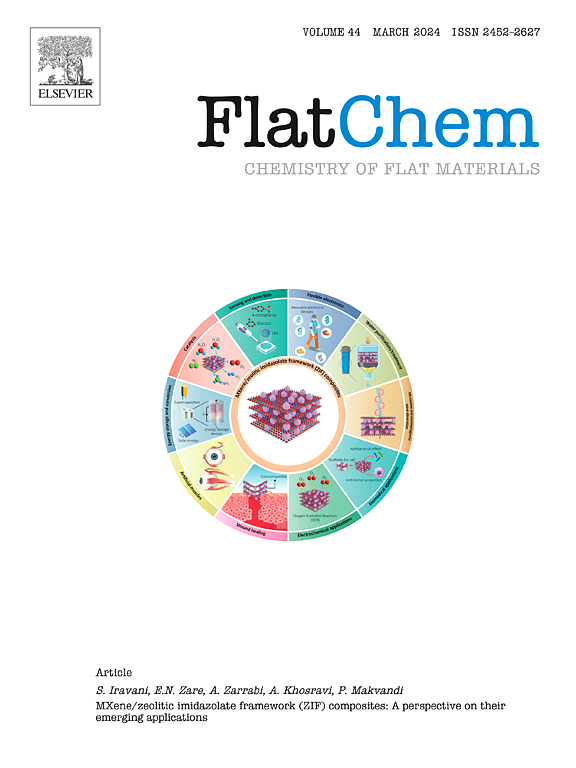An electroactive nanocomposite based on g-C3N4 and bioinspired synthesized reduced graphene oxide grafted Ag nanoparticles for p-nitrophenol detection
IF 6.2
3区 材料科学
Q2 CHEMISTRY, PHYSICAL
引用次数: 0
Abstract
We report the p-nitrophenol electrochemical sensor using a new nanocomposite composed of bioinspired synthesised ‘reduced graphene oxide grafted Ag nanoparticles and g-C3N4 ‘(AgNPs-rGO)TL’. Here, it has been prepared by simultaneous reduction of AgNO3 and graphene oxide (GO) in one pot using only a phytoextract i. e. Ocimum sanctum leaf extract as a ‘green reducer’. It is a straightforward, green and cost-effective approach. Further, it blends with graphitic carbon nitride to form a new nanocomposite (AgNPs-rGO)TL:g-C3N4 for electrocatalytic sensing of toxic ‘p-nitrophenol’ in the aqueous medium at −0.62 V. The synthesized nanocomposite was well-characterized by FTIR, XPS, XRD, SEM with EDX and TEM. Phyto-synthesized (AgNPs-rGO)TL synergistically enhances the properties of g-C3N4 such as surface coverage area and electron transportation. The newly fabricated sensor exhibited negligible influence of common interferences and performed well in a very wide linearity in two calibration ranges (0.015 μM–846 μM and 846 μM–8001 μM) and detection limit (15 nM). The real-world sample analysis was well performed.

基于g-C3N4和仿生合成还原氧化石墨烯接枝银纳米颗粒的电活性纳米复合材料用于对硝基苯酚检测
我们报道了一种新型纳米复合材料的对硝基苯酚电化学传感器,该复合材料由生物灵感合成的“还原氧化石墨烯接枝Ag纳米颗粒和g-C3N4 ' (AgNPs-rGO)TL”组成。在这里,它是通过在一个锅中同时还原AgNO3和氧化石墨烯(GO)来制备的,只使用植物提取物,即茴香叶提取物作为“绿色还原剂”。这是一种简单、环保和经济的方法。此外,它与石墨化氮化碳共混形成了一种新的纳米复合材料(AgNPs-rGO)TL:g-C3N4,用于在−0.62 V的水介质中电催化感应有毒的“对硝基苯酚”。通过FTIR、XPS、XRD、SEM、EDX和TEM对合成的纳米复合材料进行了表征。植物合成(AgNPs-rGO)TL协同增强了g-C3N4的表面覆盖面积和电子传输等性能。该传感器在0.015 μM - 846 μM和846 μM - 8001 μM两个校准范围和15 nM的检出限内具有很宽的线性度,可以忽略常见干扰的影响。真实世界的样品分析进行得很好。
本文章由计算机程序翻译,如有差异,请以英文原文为准。
求助全文
约1分钟内获得全文
求助全文
来源期刊

FlatChem
Multiple-
CiteScore
8.40
自引率
6.50%
发文量
104
审稿时长
26 days
期刊介绍:
FlatChem - Chemistry of Flat Materials, a new voice in the community, publishes original and significant, cutting-edge research related to the chemistry of graphene and related 2D & layered materials. The overall aim of the journal is to combine the chemistry and applications of these materials, where the submission of communications, full papers, and concepts should contain chemistry in a materials context, which can be both experimental and/or theoretical. In addition to original research articles, FlatChem also offers reviews, minireviews, highlights and perspectives on the future of this research area with the scientific leaders in fields related to Flat Materials. Topics of interest include, but are not limited to, the following: -Design, synthesis, applications and investigation of graphene, graphene related materials and other 2D & layered materials (for example Silicene, Germanene, Phosphorene, MXenes, Boron nitride, Transition metal dichalcogenides) -Characterization of these materials using all forms of spectroscopy and microscopy techniques -Chemical modification or functionalization and dispersion of these materials, as well as interactions with other materials -Exploring the surface chemistry of these materials for applications in: Sensors or detectors in electrochemical/Lab on a Chip devices, Composite materials, Membranes, Environment technology, Catalysis for energy storage and conversion (for example fuel cells, supercapacitors, batteries, hydrogen storage), Biomedical technology (drug delivery, biosensing, bioimaging)
 求助内容:
求助内容: 应助结果提醒方式:
应助结果提醒方式:


